It's going to happen again.
This:

or this:

clear
or even this:

Reports from Siargao Island, Philippines, plus posts about Israel when they do something outrageously criminal.
Sometimes it rains here - well, more or less, all of the time, it rains here.
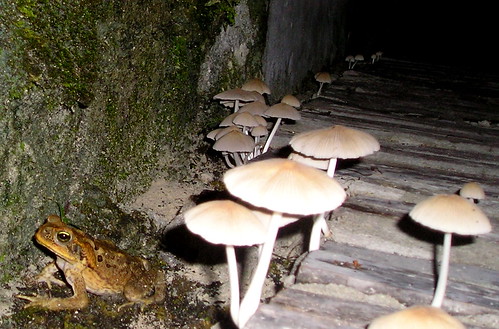

 The local kayabang crabs come out of their burrows among the near-shore coconut trees every full moon, and set out on a determined march to the beach, where they get up to ... well, I really don't know what.
The local kayabang crabs come out of their burrows among the near-shore coconut trees every full moon, and set out on a determined march to the beach, where they get up to ... well, I really don't know what. A habal-habal is the usual form of transport around here. We all rely on them.
A habal-habal is the usual form of transport around here. We all rely on them. Tamaya, octopus are one of the favourite foods here, but in my opinion, Filipinos don't do the best by them.
Tamaya, octopus are one of the favourite foods here, but in my opinion, Filipinos don't do the best by them. Strange thing, you know; since the Big Tsunami in the Indian Ocean on December 27 2006 (my birthday, as it happened) everyone has got all concerned.
Strange thing, you know; since the Big Tsunami in the Indian Ocean on December 27 2006 (my birthday, as it happened) everyone has got all concerned. So there's not much point in putting up notices like this, especially when it's distinctly ambiguous about whether you have to run 14 kilometres or just a mile.
So there's not much point in putting up notices like this, especially when it's distinctly ambiguous about whether you have to run 14 kilometres or just a mile. Tridacna clams belong to the family that is supposed to grab your foot if you're a careless diver, and hold you trapped until whatever, which is rubbish.
Tridacna clams belong to the family that is supposed to grab your foot if you're a careless diver, and hold you trapped until whatever, which is rubbish. But de-shelled, the reasons for eating this shellfish become very, very obvious.
But de-shelled, the reasons for eating this shellfish become very, very obvious. Ron was the first to find one of these local ginger plants, and I wrote about them here.
Ron was the first to find one of these local ginger plants, and I wrote about them here.
 Now, we haven't been watching these plants closely enough. (I've transplanted a few to my garden, where we can keep a eye on them).
Now, we haven't been watching these plants closely enough. (I've transplanted a few to my garden, where we can keep a eye on them).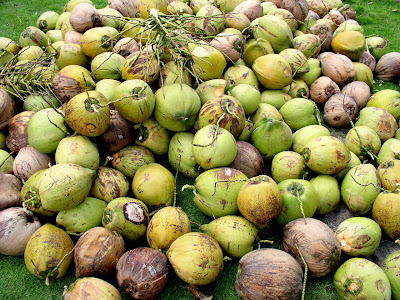 This is the usual three-monthly coconut harvest from the sixteen trees in my garden. The usual haul is 5 sacks, each of about 25 kilos kopras meat (about 100 pieces per sack).
This is the usual three-monthly coconut harvest from the sixteen trees in my garden. The usual haul is 5 sacks, each of about 25 kilos kopras meat (about 100 pieces per sack).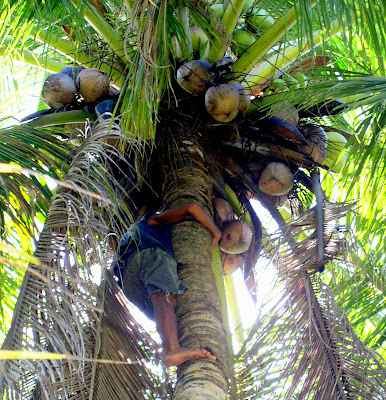 It does everything you can think of, except, possibly, marriage guidance, but it's almost certainly got a secret chemical that will help with that kind of problem.
It does everything you can think of, except, possibly, marriage guidance, but it's almost certainly got a secret chemical that will help with that kind of problem.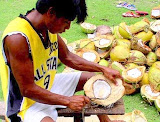

 I'm not a lot interested in fruit flies, as such, but they (Drosophila) have been a great deal helpful to science in general and especially in the genetics corner.
I'm not a lot interested in fruit flies, as such, but they (Drosophila) have been a great deal helpful to science in general and especially in the genetics corner. Curacha dancing crabs are a speciality of Zamboanga, at the extreme right hand bottom of the Philippines.
Curacha dancing crabs are a speciality of Zamboanga, at the extreme right hand bottom of the Philippines.+P1010005-1.JPG)
 And we found these, abandoned: Puso banana buds, but only the stripped skins, the buds taken off to make into a fabulous salad.
And we found these, abandoned: Puso banana buds, but only the stripped skins, the buds taken off to make into a fabulous salad.And then this one, known locally as padjaw. It's an aroid, but I don't know much more about it, and I don't know why it grows 'pretend peppers'.
 Here's a picture of one, a bud popped into a vase of water at 5pm and open and greedy at 7pm.
Here's a picture of one, a bud popped into a vase of water at 5pm and open and greedy at 7pm. local horseshoe bats. Even down to the two very small 'eyes' either side of its 'nose'.
local horseshoe bats. Even down to the two very small 'eyes' either side of its 'nose'. Every morning at 5am, as the sun rises, reluctantly, Bebot's wife makes bread rolls, and they're wonderful.
Every morning at 5am, as the sun rises, reluctantly, Bebot's wife makes bread rolls, and they're wonderful. The kids here find these spiders around the place. Then they set pairs of spiders to fight along a piece of silhig (that piece of the centre of a coconut leaf, that are normally used to make brooms here).
The kids here find these spiders around the place. Then they set pairs of spiders to fight along a piece of silhig (that piece of the centre of a coconut leaf, that are normally used to make brooms here).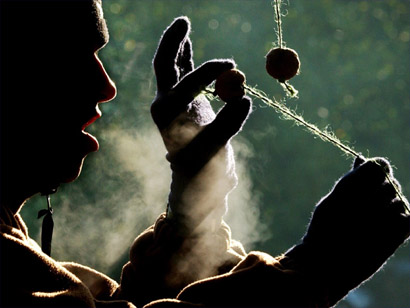 Then I think back to my own youth; we used to have conkers (horse-chestnuts) that we collected in the local woods. You strung the conker and slung it against your opponent's. If that broke, you won.
Then I think back to my own youth; we used to have conkers (horse-chestnuts) that we collected in the local woods. You strung the conker and slung it against your opponent's. If that broke, you won.
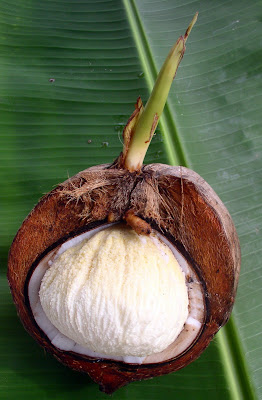 This is a coconut in the process of sprouting. It's sent out a small shoot through one of the three 'eyes' at the top of the coconut shell, and soon it will send out some roots through another one.
This is a coconut in the process of sprouting. It's sent out a small shoot through one of the three 'eyes' at the top of the coconut shell, and soon it will send out some roots through another one. Now, if you can catch a coconut that hasn't quite reached this stage (where the bubble gets a little bit spongy) then you get this, and it's delicious.
Now, if you can catch a coconut that hasn't quite reached this stage (where the bubble gets a little bit spongy) then you get this, and it's delicious. Ever since I first visited Paris, at the age of sixteen, I've had the ambition to be a Rejected Artist. I wanted to live in a garret in Paris or Soho, paint works of genius like Vincent Van Gogh, then come back from Heaven to see what nice things people said about my stuff long after I'd gone.
Ever since I first visited Paris, at the age of sixteen, I've had the ambition to be a Rejected Artist. I wanted to live in a garret in Paris or Soho, paint works of genius like Vincent Van Gogh, then come back from Heaven to see what nice things people said about my stuff long after I'd gone. The painting is good:
The painting is good:

 I've been having a lot of idle fun in the past few days, playing with the Paint.Net program. It's fun, it's free, and (I think) it does most of what you might want.
I've been having a lot of idle fun in the past few days, playing with the Paint.Net program. It's fun, it's free, and (I think) it does most of what you might want. Here, on the other hand, by Hans Memling, is an old lady who's seen it all.
Here, on the other hand, by Hans Memling, is an old lady who's seen it all. But this is the best, the Rokeby Venus, by Diego Velázquez.
But this is the best, the Rokeby Venus, by Diego Velázquez.

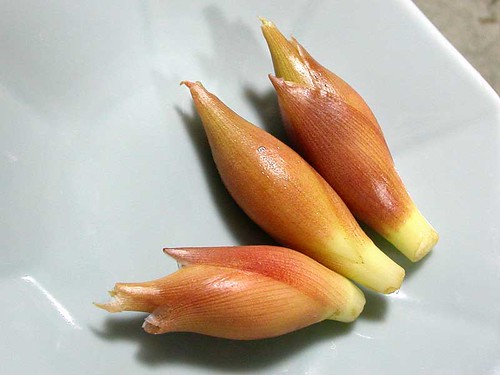 The buds are shown here:
The buds are shown here: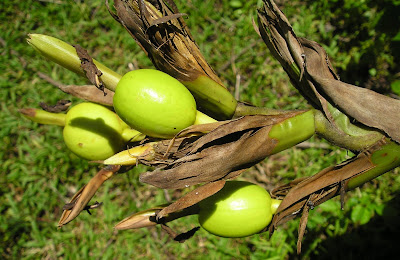
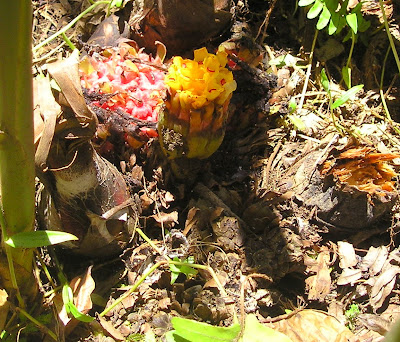 But the third wild ginger that Ron brought back turns out to be a little honey. You can see in this photo the yellow flowers and pink fruit. Here's another photo of the pink fruit.
But the third wild ginger that Ron brought back turns out to be a little honey. You can see in this photo the yellow flowers and pink fruit. Here's another photo of the pink fruit.